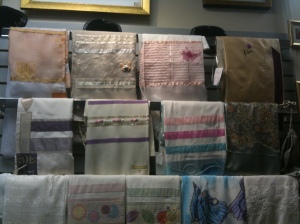Last week we visited a Judaica shop in New Jersey where there was a large selection of girls’ and women’s tallits. It is my first time seeing such a selection. I’ve seen a pink tallit or two for sale in the past but never so many tallits all in one place.
The store owner explained that they are a big seller and very popular with the Jewish conservative communities. Most girls will come in and get a tallit for their bat mitzvah.
I grew up in an orthodox community and never saw a women or girl wearing a tallit.
So it got me thinking is it okay for a female to wear a tallit? Is there any halachic problem with this?
Many ancient authorities permitted the wearing of tallit by women. In fact, I’ve read that Rashi’s daughters wore tallit and tefillin. Other famous rabbis like Rabbeinu Tam and the Rambam also permitted it. It was only in medieval times that the Maharam pushed that women not wear tallit. The Rema also stated that it’s an act of arrogance for a woman to wear a tallit. The Maharil and the Targum Yonatan Ben Uziel both state that the tallit is a “male garment” and so a woman shouldn’t wear it.
Today whether or not women should wear tallit is still being debated. Rabbi Joseph Soloveitchik has said that the woman’s intention is what makes the difference. If the woman is wearing the tallit to bring her closer to G-d, then it’s perfectly alright. However, some women wear tallit just to make a political point, usually about traditional gender status and roles (that they can be “just like men”) – in this case, it is not permitted. I guess you could ask yourself if you’re still wearing the tallit to pray even when there is nobody around to see you. There are still some orthodox rabbis who say that women should not wear tallit. However, in modern orthodoxy today it is generally accepted that women are wearing tallit for the right reasons, especially since it’s become more common and a woman is less likely to stand out for doing so.
Rabbi Moshe Feinstein, another contemporary orthodox rabbi, has said that any woman who wants to do a mitzvah can do it and be rewarded for it, even if she’s not obligated to do it. Although he does say that if she’s wearing a four-cornered garment it should have tzitzit and that it should be different from a man’s garment. I think by looking at the photos here, you can tell that women’s tallit are different from men’s. Other rabbis, such as Rabbi Yomtob ben Yisrael Alghazi and Rabbi Yisrael Yaaqob Alghazi, have encouraged and admired women who wear tallit because they inspire men to be even more strict in their mitzvot.
Anyway if you are looking for a beautiful women’s or girl’s tallit I can send you the details to the shop. I looked around online for girls’ tallits and the ones we saw in the shop were nicer.
Have a great day!
9 Responses to “Is a Woman Permitted to Wear a Tallit”








i would like to wear one. i have my deceased sabba’s talit. but in my community i would get looks like i was crazy which i don’t need or want.
” In fact, I’ve read that Rashi’s daughters wore tallit and tefillin.”
This is a well-known myth, not much more.
“Rabbi Joseph Soloveitchik has said that the woman’s intention is what makes the difference. If the woman is wearing the tallit to bring her closer to G-d, then it’s perfectly alright.”
No, he said if she’s doing it so that she can fulfill a mitzvah it’s all right. Being a Brisker, he didn’t hold from deeper reasons for mitzvot.
“Although he does say that if she’s wearing a four-cornered garment it should have tzitzit”
This is incorrect. A woman does not *need* to add tzitzit to a garment.
I think the issue of “yehora,” often translated as arrogance, is usually misconstrued. For months I struggled to understand what the Rema meant exactly, and then just last night I took another look inside and suddenly it made sense: the idea is not like someone sauntering around in a leather motorcycle jacket, rather it’s frumkeit. The point is that since she is exempt (and everyone knows it), by making a special effort to do the mitzvah she is exhibiting her piousness in an outward manner, which is forbidden.
(Yehora is forbidden not just in this case, but many others. For example, there’s a question of yehora in putting on two sets of tefillin.)
I think this is an especially salient point as we settle into Elul and work hard on improving our inner selves.
Even according to this Rema, I can’t see any reason why a woman cannot wear a tallit or tzitzit in private. (I’ve read about woman who only wear a tallit when davening at home.) If that doesn’t appeal to her, it seems to me she should rethink her decision to wear a tallit.
Ben Slobodkin
Ben’s Tallit Shop
As someone who considers herself a baal teshuva in progress, on a seemingly never-ending quest to come to observance, this is a question that I had asked a study partner of mine just last night. Having gone through the first few mitzvot listed in the Chafetz Chayim’s Concise Book of Mitvoth, I wondered why even though women are not obligated to say the Shema because it is a time-bound commandment, they are allowed to and even encouraged to when able. Meanwhile, women aren’t obligated to wear tzitzit, tefillin, etc, but are seemingly forbidden from doing so. It is this questions and others like these that present the most difficulty for me, but for which I am determined to come to a reconciliation with through further inquiry and study. Thank you for the informative post.